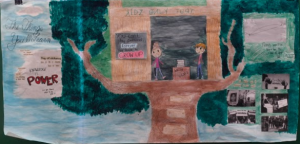
Earlier this year, a Townsend Harris High School administrator requested the removal of a student’s artwork from a fifth floor bulletin board, and those involved with the artwork are questioning the reasoning behind the descision.
Art teacher Margherita Wischerth reluctantly took the game-of-life-themed artwork down.

The visual, titled “Knowledge is Power,” depicted two children in a tree house surrounded by water guns and books and incorporated headlines and photographs related to the Black Lives Matter movement.
Class of 2015 alumnus Eli Betts created the piece and the bulletin board was put up early this fall.
Eli explained that the purpose of the piece was to “convey the innocence of childhood while showing the transition from playing pretend to the problems we actually have to face as we grow up.”
Principal and Arts Department Supervisor Anthony Barbetta says that he did not remove the artwork because it was offensive. He instead explains, “I [just] didn’t understand the bulletin board. I didn’t think there was any quality there. I’m not really a micromanager. We’ve changed boards [before]. We had changed the Honor Roll board and the Arista board because they didn’t look good.”
Some still question the administration’s request to remove an artistic display.
Eli responded to the removal, characterizing it as censorship, and stating, “Some people speak through science, while others speak through music and art. I don’t think the administration should be censoring the arts because having a creative outlet is vital to the development of students.”
Art Club President Akash Singh also commented on the piece, remarking that he did not “see why it would be taken down.”
He added that “the use of the headlines were social commentary, and the best kind of art says something that may even be critical about the status quo, but this school is very much driven towards maintaining order.”
He continued, “I think there’s always this fear, especially in public schools, that you should be wary of offending people.”
Mr. Barbetta stated, “I just don’t think there are certain things that are worth upsetting people over. It’s not everyday a bulletin board is taken down. If it looks old or outdated, I’m going to ask for it to be changed.”
Ms. Wischerth responded, “I just don’t understand why someone might find it offensive because [the artwork] incorporated real headlines from newspapers. It’s very ironic. If it wasn’t considered offensive in print, why are people provoked by it when they see it visually?”
“In my opinion, people tend to get offended faster from the visualization because it’s easier to understand and very clear. You don’t have to connect any dots in a visual work like you do for written words,” she added.


























